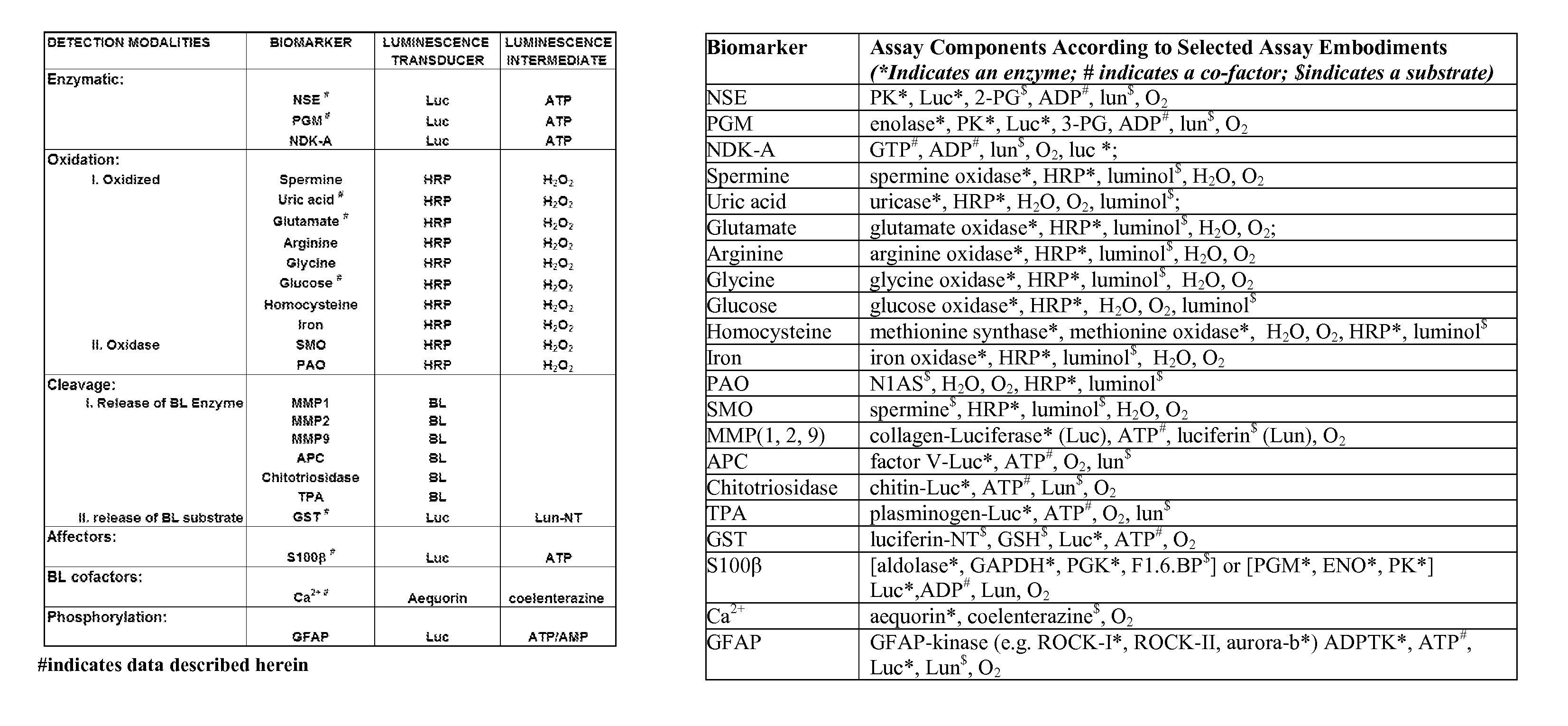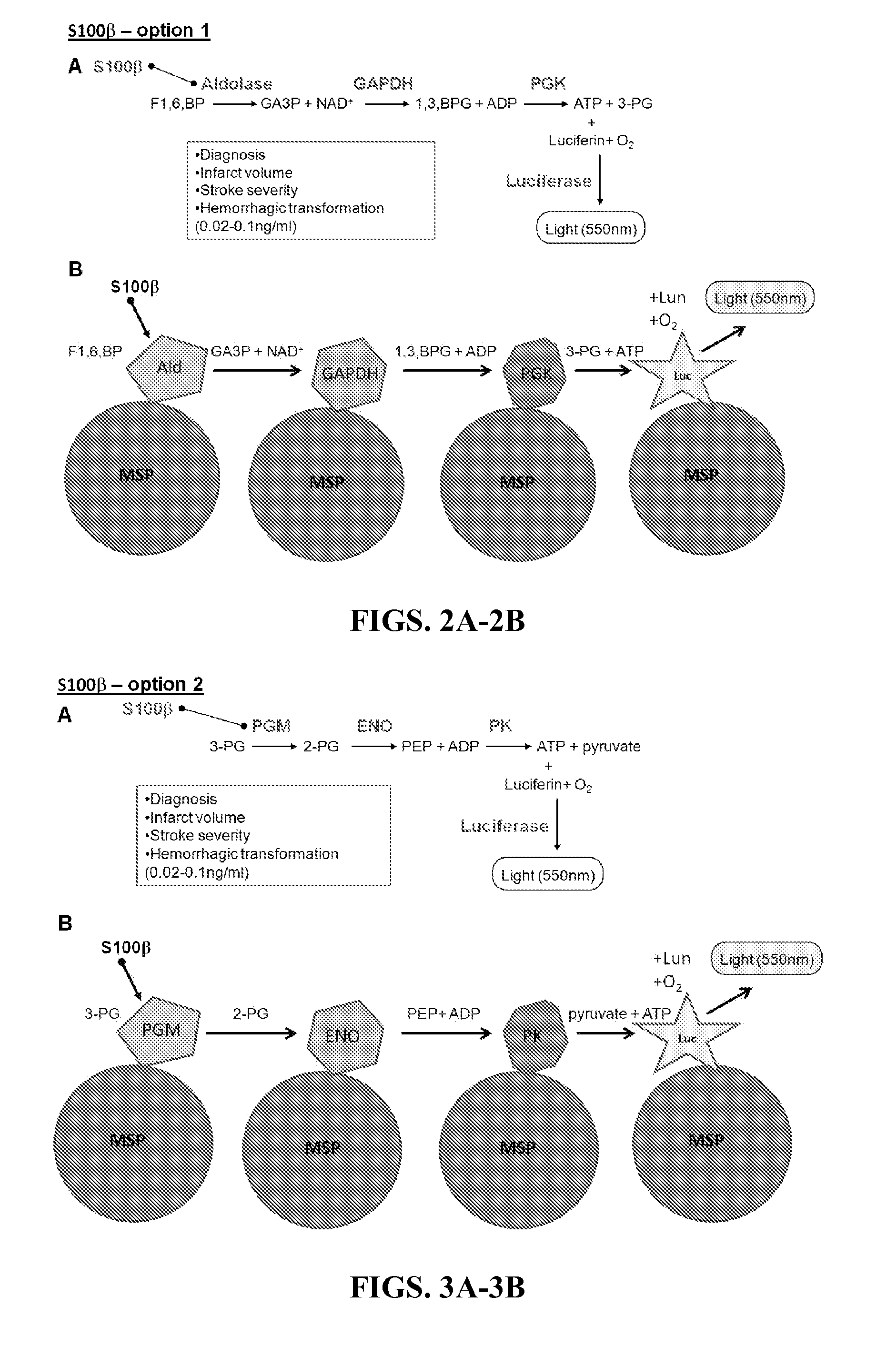Immobilized protein system for rapid and enhanced multiplexed diagnostics
a protein system and multiplexing technology, applied in multi-enzyme systems, biochemistry apparatuses and processes, instruments, etc., can solve the problems of time-consuming and expensive, blood biomarkers for neural injuries have received much attention, and are not widely available, so as to facilitate signal amplification and reduce the cost of fabrication, the effect of easy mass production
- Summary
- Abstract
- Description
- Claims
- Application Information
AI Technical Summary
Benefits of technology
Problems solved by technology
Method used
Image
Examples
example 1
Tethered Enzymes Improve Cascading Assay Reaction Kinetics
[0188]Tethering one or more proteins involved in the reaction cascades to a scaffold can provide several advantages. First, it can confine either the detection reaction or the readout signal to a certain area of the diagnostic card. This would allow in-line background luminescence control readings and also reduce the size of the photodetector apparatus. In addition, tethering of enzymes has been shown to provide enhancement of enzyme stability (Liang et al., “Biomedical Application of Immobilized Enzymes,”J. Pharm. Sci. 89(8):979-90 (2000), which is hereby incorporated by reference in its entirety), and to improve reaction kinetics (FIGS. 30A-30B)) (see Mukai et al., “Sequential Reactions of Surface-Tethered Glycolytic Enzymes,”Chem. Biol. 16(9):1013-20 (2009) and Blum et al., “Collagen Strip with Immobilized Luciferase for ATP Bioluminescent Determination,”Biotechnol. Bioeng. 27(3):232-7 (1985), which are hereby incorporated...
example 2
Assays According to the Present Invention Detect Neural Injury Biomarkers
[0190]Each detection modality described supra was tested to determine that the coupled reactions described could indeed detect the presence of the biomarker in the complex environment of human serum. For these experiments, representative biomarkers we utilized from different detection modalities (enzymatic: NSE, PGM; oxidative: UA, glutamate, glucose; cleavage: GST; affector: S100β; BL cofactor: Ca2+). These examples were chosen based on their reported relevance to neural injury (Whiteley et al., “Blood Biomarkers in the Diagnosis of Ischemic Stroke: A Systematic Review,”Stroke 39(10):2902-9 (2008); Saenger and Christenson, “Stroke Biomarkers: Progress and Challenges for Diagnosis, Prognosis, Differentiation, and Treatment,”Clin. Chem. 56(1):21-33 (2010); Whiteley et al., “Blood Markers for the Prognosis of Ischemic Stroke: A Systematic Review,”Stroke 40(5):e380-9 (2009), which are hereby incorporated by refere...
example 3
Detection of NSE, UA, Glutamate, and S100β
[0192]To demonstrate several detection modalities, an animal model for neural injury was used to generate samples that were then screened for a panel of four biomarkers (NSE, UA, glutamate and S100β). For these experiments, control and experimental rats were anesthetized and given craniectomies to allow access to the brain. A stroke was induced in the experimental rats by heat ligation / coagulation of a major blood vessel. Plasma samples were taken at various time points including −1 hr, 0 hr (stroke is induced), 1 hr, 2 hr, 3 hr, 4 hr and 6 hr for both the control and stroke rat. The control rat data demonstrated the impact of both the anesthesia and the surgical procedure itself on the biomarkers, confirming that any change in biomarker amounts detected did reflect neural damage due to the vessel occlusion and not other aspects of the surgical procedure or anesthesia. A total of 8 rats were included in this experiment. Results are shown in ...
PUM
| Property | Measurement | Unit |
|---|---|---|
| time | aaaaa | aaaaa |
| time | aaaaa | aaaaa |
| time | aaaaa | aaaaa |
Abstract
Description
Claims
Application Information
 Login to View More
Login to View More - R&D
- Intellectual Property
- Life Sciences
- Materials
- Tech Scout
- Unparalleled Data Quality
- Higher Quality Content
- 60% Fewer Hallucinations
Browse by: Latest US Patents, China's latest patents, Technical Efficacy Thesaurus, Application Domain, Technology Topic, Popular Technical Reports.
© 2025 PatSnap. All rights reserved.Legal|Privacy policy|Modern Slavery Act Transparency Statement|Sitemap|About US| Contact US: help@patsnap.com



